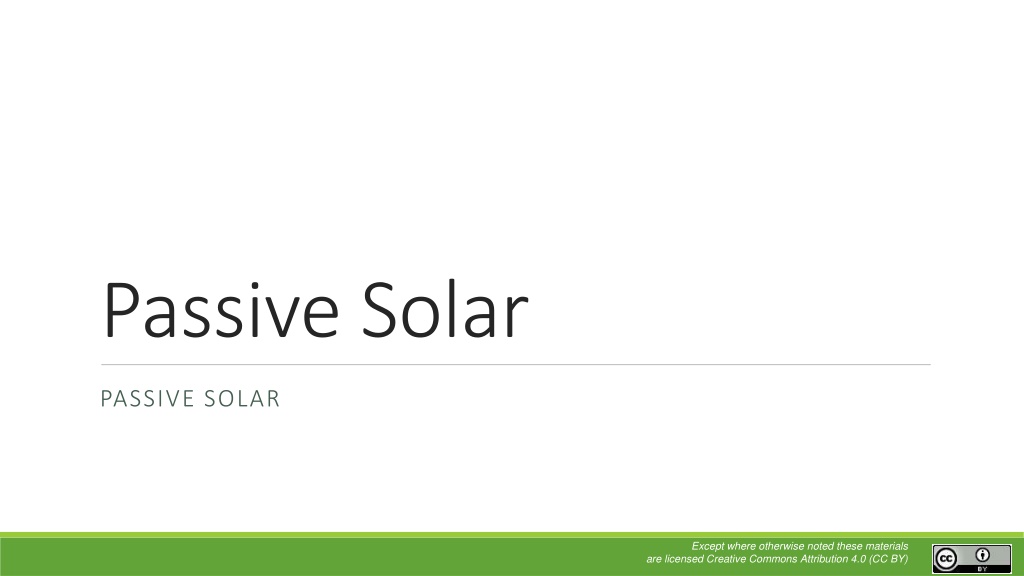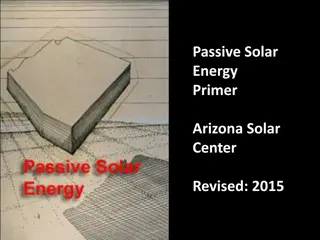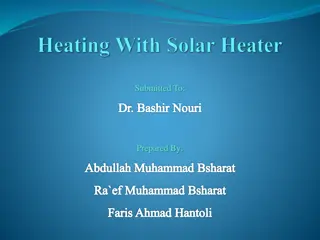Understanding Passive Solar Design and Its Benefits
Passive solar design utilizes seasonal changes in the sun's path to naturally heat structures, providing benefits such as energy efficiency, reduced environmental impact, and cost savings. By leveraging the sun's warmth in winter and minimizing heat gain in summer, passive solar design offers a sustainable approach to building design that can enhance comfort and lower utility costs.
- Passive Solar Design
- Energy Efficiency
- Sustainable Architecture
- Sunlight Utilization
- Environmental Impact
Download Presentation

Please find below an Image/Link to download the presentation.
The content on the website is provided AS IS for your information and personal use only. It may not be sold, licensed, or shared on other websites without obtaining consent from the author. Download presentation by click this link. If you encounter any issues during the download, it is possible that the publisher has removed the file from their server.
E N D
Presentation Transcript
Passive Solar PASSIVE SOLAR Except where otherwise noted these materials are licensed Creative Commons Attribution 4.0 (CC BY)
The objective of this unit is to present the student with some basic terms relating to passive solar and design components. Upon completion, the student will have an understanding of the following: Passive solar design Seasonal sun paths Sun altitudes Benefits of passive solar Passive design elements Objectives Direct, indirect and sunspaces Passive Solar
Passive solar design uses seasonal changes in the path of the sun to create structures that are heated by natural means. The earth rotates once each day about an axis that is tilted 23.5 with respect to its orbit around the sun. The direction of tilt remains fixed as the earth moves, thus changing the earth s orientation with respect to the sun. The direction and tilt are what creates seasons. When the hemisphere is tilted towards the sun, the days are longer and warmer. When the hemisphere is tilted away from the sun, the days are shorter and colder. The hemisphere tilted toward the sun experiences summer. The hemisphere tilted away from the sun experiences winter. The seasons spring and fall occur when tilt is parallel to the orbital direction. Spring and fall equinoxes occur when there is no hemisphere tilt toward or away from the sun. Passive Solar Design Passive Solar
Seasonal Sun Paths Rhcastilhos [Public domain]. Retrieved from https://en.wikipedia.org/wiki/File:Seasons.svg Passive Solar
The winter sun is relatively low in the sky, and light comes almost entirely from the south. Building Design Benefits from Knowing the Altitude of the Sun D.P. Stern. NASA [Public domain]. Retrieved from https://www-spof.gsfc.nasa.gov/stargaze/Ssky.htm USGS [Public domain]. Retrieved from https://landsat.usgs.gov/landsat-7-data-users-handbook-section-5 Passive Solar
Best known for capturing the warmth of the sun in the winter months and preventing unwanted heat gain in the summer. Can help cool buildings in the summer by establishing sun-induced ventilation Provides the ability to reduce energy use, which in turn will reduce the impact on the environment Will allow for smaller heating, ventilation and cooling units Provides some insurance against spikes in utility costs Reduces lighting needs and costs Passive Solar Design Passive Solar
1. Site specific 2. Adapted to local climate 3. Southern orientation of the glazing will promote heat gain in winter months for cold climates. 4. North-facing glazing and ample ventilation for warmer climates along with being well-insulated to deter heat gain Passive Solar Design Parameters 5. Ability to collect and store heat 6. Properly manage sun entering the building City of Santa Fe [Public domain]. Retrieved from https://www.santafenm.gov/passive_solar Passive Solar
Element Examples Aperture Windows, cavity opening Wall or floor, black metal baffle barrel, dark hoses or pipes Heat absorbing surface Thermal mass Concrete, stone, brick, sand, water Passive Solar Design Elements Arrangement and coloration of interior panels. Surface conduction and radiation, vents or ducts, interior windows and doors Heat distribution Roof eaves and awnings, landscaping, window coatings/coverings/ sunscreens, pergolas Control mechanisms Passive Solar
1. 2. 3. Windows are the most common form. The correct size, number and type of window depends on climate. For climates that need heating, a southern exposure and windows that have large solar heat gain coefficients (SHGCs) is recommended. SHGC: A value between 0 and 1 that measures the fraction of the sun s heat passing through a window. Windows on the east, west and north sides should have low SHGCs because they are primarily illuminated in the summer when heat gain is not wanted. Windows need low-E (low emissivity) coatings. Low-E windows limit the passage of heat by radiation. Block interior heat from leaking to cold (winter). Block exterior heat from entering cool interior (summer). 4. Aperture 5. Passive Solar
Heat-absorbing surface Surface the sunlight hits after it has passed through aperture Dark-colored surfaces perform better by preventing sunlight from reflecting back out the aperture. The floor surface could be tile or a dark paint. Surface of a barrel possibly holding water Thermal mass Allows radiant heat collected during the day to be stored and released gradually at night The amount of thermal mass required depends on the required amount of heat that needs to be absorbed during the day and the length of time to disperse. Barrel of water (Water has highest specific heat of 1) Heat-Absorbing Surface and Thermal Mass Figure by MIT OpenCourseWare [CC BY NC SA 2.0]. Retrieved from https://www.flickr.com/photos/mitopencourseware/3360395236/in/albu m-72157615376527602/ Louisiana DNR [Public domain]. Retrieved from http://www.dnr.louisiana.gov/assets/TAD/edu cation/ECEP/drafting/c/c.htm Passive Solar
An effective design requires a means to deliver heat evenly throughout the house. This is accomplished by: Radiation from warmed surfaces Convective air movements through windows, doors or vents Directly by conduction across materials A true passive design would incorporate an open floor plan relying on natural conduction, convection and radiation. Buildings with many isolated rooms rely on mechanical means for even heat distribution. Heat Distribution Department of Energy [Public domain]. Retrieved from https://commons.wikimedia.org/wiki/File:Illust_passive_solar_d1.gif Passive Solar
Control mechanisms regulate when and how much solar energy enters a structure. 1. The most common mechanisms in passive design are awnings and roof eaves. 2. The size of the windows and geometry of the eaves and awnings determine when sunlight enters. 3. Awnings work well because they can be positioned in the winter to let sun in and repositioned in the summer. Control Mechanisms 4. Deciduous trees positioned to block sun 5. Window coverings in cold climates require the shade on the inside and in warm climates require the shade on the outside. D.P. Stern. NASA [Public domain]. Retrieved from https://www-spof.gsfc.nasa.gov/stargaze/Ssky.htm [ 8 ] Passive Solar
The most common and simplest type of passive solar design system South-facing windows are most practical in cold climates, incorporated with good glazing. Thermal mass should be at a minimum of 5 times greater than aperture. Thermal mass is decided in design process and cannot be estimated. If the floor is the primary thermal mass, it should be dark in color while walls and ceilings are light in color. The floor will absorb; whereas, the walls will reflect. Direct Gain If walls are used for storage, then they should be a dark color. Figure by MIT OpenCourseWare [CC BY NC SA 2.0]. Retrieved from https://www.flickr.com/photos/mitopencourseware/3359470269 Passive Solar
Heat an exterior surface to the living space and use natural forms of heat transfer to maintain temperature. These systems include thermal storage walls and thermosiphon. Thermal storage walls (Trombe wall) Thickness and conductivity of the wall is critical: It must be massive enough to absorb and sufficiently conductive. Composed of concrete, adobe or other masonry products Selective coatings on trombe can improve solar absorption. The wall will prevent the sunlight from directly illuminating the room. Most effective in climates where it has daily sunlight (desert) Indirect Gain Systems Figure by MIT OpenCourseWare [CC BY NC SA 2.0]. Retrieved from https://www.flickr.com/photos/mitopencourseware/3359628993/in/album- 72157615376527602/ Passive Solar
A form of indirect gain that relies on sunlight and natural convection to move air without mechanical assistance Can either warm or cool depending on the system Solar energy heats an absorbing surface that will warm the surrounding air. The hot air rises, drawing in cold air and creating a convective loop. A closed loop system draws cool air from a building, warms it, and returns it to the building. Open Loop solar chimney An open loop system draws air from the exterior; a solar chimney would operate on this premise. Thermosiphons Shypoetess [CC BY-SA 3.0]. Retrieved from https://commons.wikimedia.org/wiki/File:Solar_chimney-en.svg Passive Solar
Some spaces combine direct gain and indirect gain systems. These may be referred to as isolated systems since they are able to function independently. The sun directly heats a space through southern exposures. The space shares its warmth either by conduction, utilizing a wall or convective currents. Thermal mass or barrels of water help to moderate temperature swings. Sunspaces Due to the construction of rooms, the structure will experience large temperature swings from day to night. Control may be as simple as closing a door. Figure by MIT OpenCourseWare [CC BY NC SA 2.0]. Retrieved from https://www.flickr.com/photos/mitopencourseware/3360395236/in/albu m-72157615376527602/ Passive Solar
Upon completion of this unit, students should be able to Discuss and define components of a passive solar design Define the seasonal sun path around the sun Understand the importance of sun altitude when designing Identify the five components of design and provide examples Define indirect, direct, thermosiphon, and sunspaces Provide examples of indirect, direct, thermosiphon, and sunspaces and explain how they operate Conclusions This presentation was prepared by Northeast Iowa Community College under award EG-17-004 from the Iowa Energy Center. Any opinions, findings, and conclusions or recommendations expressed in this material are those of the author(s) and do not necessarily reflect the views of the Iowa Energy Center. Passive Solar

























